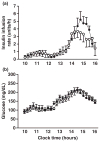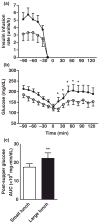Antecedent caloric intake and glucose excursion following a subsequent meal in Type 1 diabetes
- PMID: 20700478
- PMCID: PMC2917830
- DOI: 10.1111/j.1753-0407.2009.00044.x
Antecedent caloric intake and glucose excursion following a subsequent meal in Type 1 diabetes
Abstract
Background: In the present study, we tested the hypothesis that calories consumed at a prior meal (lunch) may impair glycemic control after a subsequent meal (supper) even if the pre-supper glucose did not differ regardless of the size of the lunch meal.
Methods: Nine subjects with Type 1 diabetes using continuous subcutaneous (s.c.) insulin infusion (CSII) therapy were studied on two separate days. Lunch (1200 h) was randomly assigned as 25% or 50% of the usual daily intake on alternate study days. The CSII was stopped at 1000 h on the day of the study and glucose was controlled until supper by adjusting the rate of intravenous (i.v.) insulin based on glucose measurements every 15 min. The CSII was restarted 1 h before supper and i.v. insulin discontinued 15 min before the first bite of supper. An identical supper meal and pre-supper s.c. bolus of short-acting insulin were administered on both visits.
Results: Pre-supper glycemia was nearly identical on each of the two study days. However, the post-supper glucose area under the curve was 27.5% greater on the day of the antecedent large lunch compared with the small lunch (P = 0.0039).
Conclusions: For optimal postprandial glucose control, people with Type 1 diabetes may need to consider not only anticipated meal calories, but also prior food intake, a practice not commonly recommended based on currently used insulin dosing algorithms.
Keywords: blood glucose; diet; insulin; insulin infusion systems.
Figures


Similar articles
-
Effects of a large supper on glucose levels the following morning in patients with type 2 diabetes.J Diabetes Complications. 1998 Mar-Apr;12(2):61-4. doi: 10.1016/s1056-8727(97)00073-1. J Diabetes Complications. 1998. PMID: 9559482
-
Evaluation of a novel continuous glucose monitoring-based method for mealtime insulin dosing--the iBolus--in subjects with type 1 diabetes using continuous subcutaneous insulin infusion therapy: a randomized controlled trial.Diabetes Technol Ther. 2012 Nov;14(11):1043-52. doi: 10.1089/dia.2012.0145. Epub 2012 Sep 24. Diabetes Technol Ther. 2012. PMID: 23003329 Free PMC article. Clinical Trial.
-
Optimal insulin pump dosing and postprandial glycemia following a pizza meal using the continuous glucose monitoring system.Diabetes Technol Ther. 2005 Apr;7(2):233-40. doi: 10.1089/dia.2005.7.233. Diabetes Technol Ther. 2005. PMID: 15857224 Clinical Trial.
-
Preprogrammed intravenous insulin infusion in diabetic humans: metabolic consequences of altering meal size.Diabetes Care. 1986 May-Jun;9(3):283-90. doi: 10.2337/diacare.9.3.283. Diabetes Care. 1986. PMID: 3525058
-
Continuous subcutaneous insulin infusion attenuated glycemic instability in preschool children with type 1 diabetes mellitus.Diabetes Technol Ther. 2007 Aug;9(4):339-47. doi: 10.1089/dia.2006.0038. Diabetes Technol Ther. 2007. PMID: 17705689
Cited by
-
Evaluation of the Effect of Carbohydrate Intake on Postprandial Glucose in Patients With Type 1 Diabetes Treated With Insulin Pumps.J Diabetes Sci Technol. 2016 Nov 1;10(6):1287-1293. doi: 10.1177/1932296816646797. Print 2016 Nov. J Diabetes Sci Technol. 2016. PMID: 27137456 Free PMC article.
References
-
- Tibaldi J. Initiating and intensifying insulin therapy in type 2 diabetes mellitus. Am J Med. 2008;121 (Suppl):S20–9. - PubMed
-
- Bode BW, Tamborlane WV, Davidson PC. Insulin pump therapy in the 21st century. Strategies for successful use in adults, adolescents, and children with diabetes. Postgrad Med. 2002;111:69–77. - PubMed
-
- Tamborlane WV, Fredrickson LP, Ahern JH. Insulin pump therapy in childhood diabetes mellitus: guidelines for use. Treat Endocrinol. 2003;2:11–21. - PubMed
-
- Taylor R, Price TB, Katz LD, Shulman RG, Shulman GI. Direct measurement of change in muscle glycogen concentration after a mixed meal in normal subjects. Am J Physiol. 1993;265:E224–9. - PubMed

